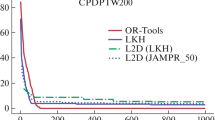Abstract
In the orienteering problem, we are given a transportation network in which a start point and an end point are specified. Other points have associated scores. Given a fixed amount of time, the goal is to determine a path from start to end through a subset of locations in order to maximize the total path score. This problem has received a considerable amount of attention in the last ten years. The traveling salesman problem is a variant of the orienteering problem. This paper applies a modified, continuous Hopfield neural network to attack this NP-hard optimization problem. In it, we design an effective energy function and learning algorithm. Unlike some applications of neural networks to optimization problems, this approach is shown to perform quite well.
Similar content being viewed by others
References
I.M. Chao, Algorithms and solutions to multi-level vehicle routing problems, Ph.D. Dissertation, Applied Mathematics Program, University of Maryland, College Park, MD (1993).
G.A. Croes, A method for solving traveling-salesman problems, Operations Research 6(1958)791–812.
B. Golden, A. Assad and R. Dahl, Analysis of a large-scale vehicle routing problem with an inventory component, Large Scale Systems 7(1984)181–190.
B. Golden, L. Levy and R. Vohra, The orienteering problem, Naval Research Logistics 34(1987)307–318.
B. Golden, Q. Wang and L. Liu, A multifaceted heuristic for the orienteering problem, Naval Research Logistics 35(1988)359–366.
P.C. Keller, Algorithms to solve the orienteering problem: A comparison, European Journal of Operational Research 41(1989)224–231.
G. Laporte and S. Martello, The selective traveling salesman problem, Discrete Applied Mathematics 26(1990)193–207.
A.C. Leifer and M.S. Rosenwein, Strong linear programming relaxations for the orienteering problem, European Journal of Operational Research 73(1994)517–523.
S. Lin, Computer solutions of the traveling salesman problem, Bell Systems Technical Journal 44(1965)2245–2269.
R.S. Pillai, The traveling salesman subset-tour problem with one additional constraint (TSSP+1), Ph.D. Dissertation, The University of Tennessee, Knoxville, TN (1992).
J.Y. Potvin, The traveling salesman problem: A neural network perspective, ORSA Journal on Computing 5(1993)328–348.
R. Ramesh and K.M. Brown, An efficient four-phase heuristic for the generalized orienteering problem, Computers & Operations Research 18(1991)151–165.
R. Ramesh, Y. Yoon and M. Karwan, An optimal algorithm for the orienteering tour problem, ORSA Journal on Computing 4(1992)155–165.
P.R. Sokkappa, The cost-constrained traveling salesman problem, Ph.D. Dissertation, The University of California, Livermore, CA (1990).
T. Tsiligirides, Heuristic methods applied to orienteering, Journal of the Operational Research Society 35(1984)797–809.
Q. Wang, X. Sun, and B. Golden, Neural networks as optimizers: A success story, in:Intelligent Engineering Systems Through Artificial Neural Networks: Volume 3, ed. C. Dagli, L. Burke, B. Fernández and J. Ghosh (ASME Press, 1993) pp. 649–656.
Author information
Authors and Affiliations
Rights and permissions
About this article
Cite this article
Wang, Q., Sun, X., Golden, B.L. et al. Using artificial neural networks to solve the orienteering problem. Ann Oper Res 61, 111–120 (1995). https://doi.org/10.1007/BF02098284
Issue Date:
DOI: https://doi.org/10.1007/BF02098284




